Spoon Fishing For Steelhead In Rivers: Methods Of Top Guides
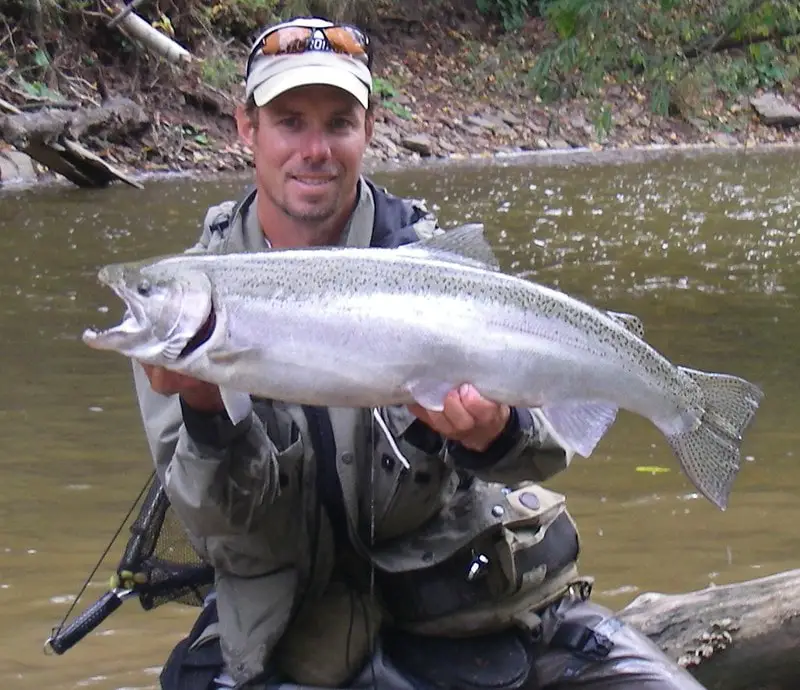
If you have read my other articles, you know I’m a veteran steelhead guide who has learned many fishing methods from other great guides. But my best lesson on spoon fishing for steelhead actually came from a client, and I now catch a lot more steelhead.
When this client arrived, I assumed he would want to fish with bait below a float all day.
But he came out with a spinning rod and reel and a box full of spoons and told me all he wanted to do was fish with spoons. He said, “Just show me where to fish, and I will do the rest.”
Usually, when I hear a customer tell me that we catch few, if any fish.
But they say the customer is always right, so I let him fish his way! I ate crow for the rest of the day as I watched in amazement how he worked his spoons and caught multiple steelhead out of nearly every spot we fished.
He caught at least twice as many steelhead as every other angler we talked to on the river that day. He even pulled fish out of spots that had just been fished by other anglers who caught nothing in that spot.
I asked him where he learned to fish spoons so well. He told me that he lived in another state for a few years for work, and a steelhead guide there taught him this technique.
I’d fished spoons for steelhead before, but his methods were different and much better. That day, I learned a valuable lesson that has translated into a lot more fish for my clients in the future.
Since then, I’ve spent over ten years mastering his spoon-fishing methods.
I know that even when steelhead are not interested in other baits, a well-presented spoon can still provoke strikes due to its ability to trigger the steelhead’s aggressive instincts for eating baitfish.
The way I work spoons now is very different than how the majority of anglers use spoons when fishing for steelhead in the rivers, from the shore at the river mouth, or at the beaches.
What You Need To Know For More Steelhead On Spoons
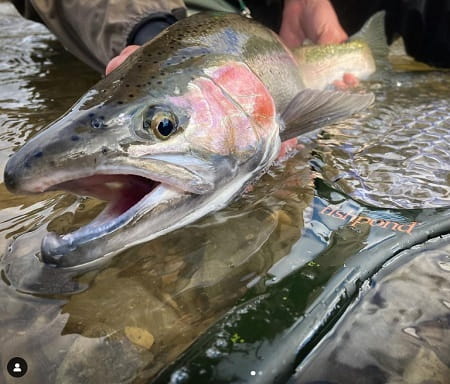
- Use spoons that are suitable for the water and this technique. This includes the type, size, and color.
- Master these two most effective spoon presentations.
- Learn to cover the water effectively from top to bottom, which means knowing where your spoon should be in the water column.
- Know how to efficiently cover every spot so you don’t miss fish.
- Work your spoon in a way that triggers more bites, but still enables you to detect bites.
I’ll discuss all of this below.
When I guide for steelhead with spoons, my approach depends on various factors, such as river conditions, depth, clarity, current speed, and the steelhead’s activity level.
Choosing the most effective spoon type, color, and size, based on these conditions is also important.
Steelhead Spoon Fishing Basics
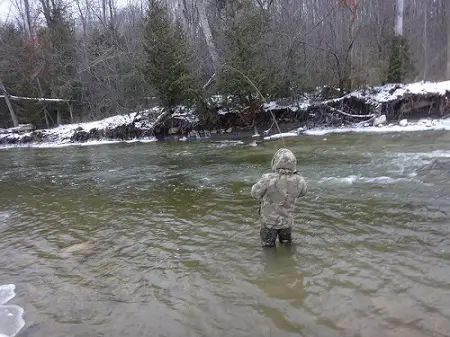
Due to their time spent in the ocean, steelhead will instinctively grab anything resembling baitfish, which spoons do well.
The lifelike appearance and movement of spoons effectively trigger a strike response from steelhead.
Casting and retrieving the spoon in the right direction, as well as working your spoon, can significantly increase your chances.
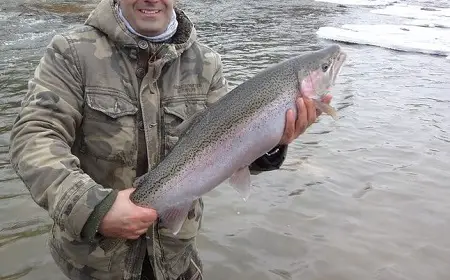
You can cover the water quickly as well and cover multiple depths.
The spoons need to be the right size, color, and weight. The steelhead spoons I recommend below can create flash, vibration, and the right action in the water.
Best Spoons For Steelhead Fishing

There are two types of steelhead spoons, but only one type should be used for casting.
- Trolling Spoons: These lightweight spoons are specifically designed for trolling and are not suitable for casting or currents. They are too light to cast, don’t sink well, and they tend to spin out of control and pop out of the water in faster currents. Avoid using these spoons in rivers.
- Casting Spoons: Heavier casting spoons have better casting distance due to their heavier weight, sink faster, have an enticing wobble, and work well in moving currents. They are the preferred spoons for steelhead fishing that other guides and I use.
Spoon Sizes: The best casting spoons range from 3 to 5 inches in length, which closely matches the size of prevalent baitfish in the river or the baitfish they have been feeding on in the ocean.
Three to 4 inches is usually perfect and is a large enough target to attract the attention of steelhead.
As a general rule, use larger spoons in turbid or high-flow conditions or near the mouth of the river. Smaller spoons are better in clear water or when targeting cautious fish holding in pools further up the river.
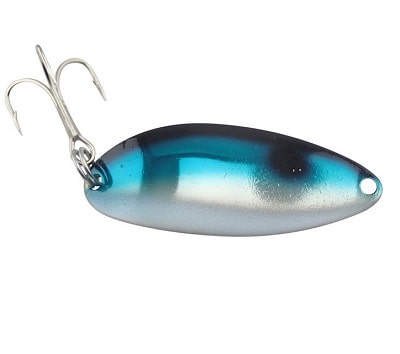
Hooks: I leave the treble hook on for pier and open water shor fishing, but I always put on a large single-hook on all my river spoons.
Here are some highly recommended spoons for steelhead fishing in rivers:
- Little Cleos: The Little Cleo Spoon might be the most popular steelhead spoon on the market. It’s great in the river and for casting off the pier or shoreline. The 1.25-ounce, 3-inch size is ideal for large water bodies and long casts.
- Mepps Cyclops: Available in 3.5 inches and various colors, these longer thinner spoons are versatile and suitable for all three retrieval methods I’ll discuss below.
- Krocodile Spoon: The 3.5-inch size is considered the best and most effective spoon for steelhead. This is a great spoon for rivers and pier fishing.
- Eppinger Dardevle: The 1-ounce, 3.5/8-inch spoon is a go-to choice for aggressive steelhead in the lower river. It is a highly rated and reliable spoon that works great for steelhead.
- Thomas Speedy Shiner Spoon: This 4-inch spoon works well in rivers for big steelhead that are regressive and want a large spoon. I use this spoon in bigger and faster rivers.
Check out more spoon options and some other favorite steelhead lures of mine.
What Color Spoons Are Best For Steelhead?
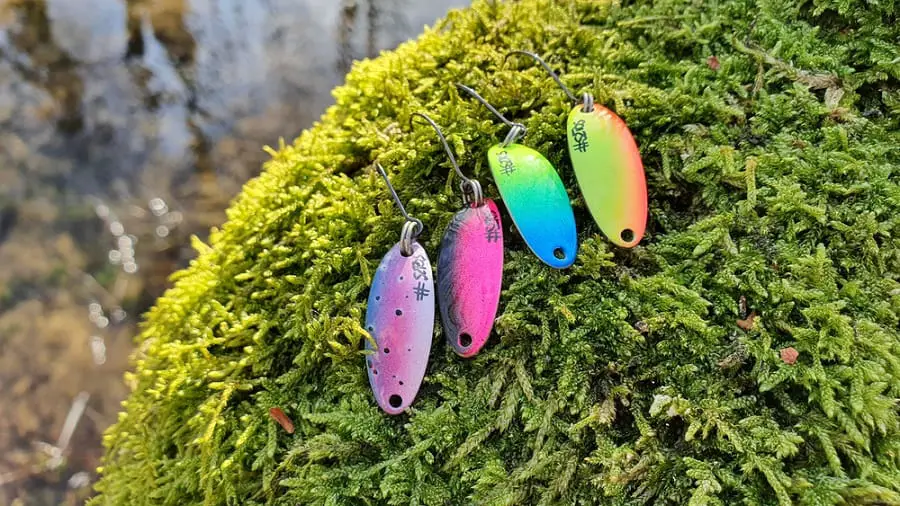
The color of the spoon can also influence the steelhead to bite.
Silver, gold, or brightly colored spoons with reflective surfaces are often the most effective, as they create a flash that can be seen from a distance. Under specific conditions, black spoons or black/silver combinations can also be highly effective.
Based on my experience, the most effective spoon colors for steelhead fishing in rivers are chartreuse, chartreuse/silver, silver, silver/orange, green/silver, and blue/silver.
How To Fish A Spoon
There are three effective techniques for catching steelhead with spoons.
Method #1: The most commonly used technique involves casting the spoon into the river and then retrieving it straight in with a slow but steady retrieve. Depending on the depth and speed of the river, you may need to let the spoon sink a bit or a lot. Most anglers cast to random spots or fan cast. This is the least effective method.
Method #2: This technique works best in faster currents. Cast the spoon across or slightly downriver, and let the current swing the lure across the pool without any reeling. This “swing” technique carries the spoon downstream and across as it sinks, wobbles, and entices the steelhead to bite.
Adding some ripping, twitching, and dropping can significantly increase the amount of steelhead that will bite.
Method #3 – Most Effective: With this method, cast the lure out and across the river, allowing it to sink to the bottom. Lift the rod tip from waist high to a few feet over your head, then lower the rod with slight tension on the line, allowing the spoon to hit the bottom, and repeat.
This creates a jigging up and down motion, causing the spoon to flutter like an injured baitfish on the way down, which can trigger the steelhead’s aggressive response.
Ripping, twitching, and changing up the lift and drop, such as lift, lift and drop, can significantly increase your success.
This jigging method is what my client showed me and is how other guides and I fish spoons.
How Fast To Reel A Spoon For Steelhead?
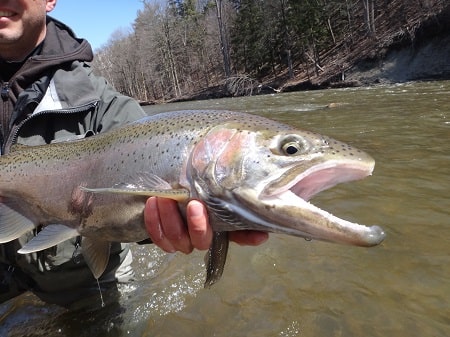
Your spoon should wobble back and forth and not spin.
To achieve a desirable side-to-side wobble, reel or retrieve the spoon at an appropriate speed, usually slow to medium speed.
However, some spoons can be reeled in faster, and other spoons need a slower retrieval. If the spoon spins or pops out on the surface, you are reeling too fast.
When the spoon is close to you as you reel in, watch its action, adjust your retrieve speed, and look for that side-to-side wobble, then remember this speed. However, if the current is faster out in the middle of the river, you should slow down your reeling to accommodate for the speed of the current.
In very fast currents, you may not need to reel at all and instead just let the lure swing across the river.
The faster you reel a spoon, the higher in the water column the spoon will stay, which may not be ideal for catching steelhead.
How Deep To Fish Spoons For Steelhead
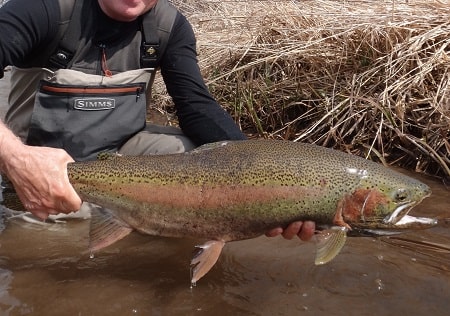
Most of the time, the steelhead will be close to the bottom, but that doesn’t mean that is where your spoon should be.
To achieve the right depth with your spoon, aim for approximately 3 feet above the steelhead’s head. In very clear water, you may need to adjust and target depths of 5 to 6 feet above their heads.
The goal is to keep the lure within their feeding range. Since steelhead prefer to feed upwards, it’s important to keep the spoon off the bottom and over their heads.
In my opinion, getting your spoon closer to the steelhead increases the likelihood of provoking a reaction strike, so the closer, the better, as long as it’s not under them.
Fishing Spoons High and Low In The Water Column
When steelhead fishing with spoons, there are two approaches to positioning the lure in the water. Most of the time the steelhead will be on the bottom, however, at times, they may be suspended.
Fishing Spoons High For Steelhead
In shallower rivers or shallow spots under 6 feet deep, you can start reeling as soon as the spoon hits the water to keep it high in the water column. Sometimes, the spoon may only be a foot or two below the surface which can be deep enough if the spot is 5 feet deep or less.
In shallow water, you may also need to keep your rod tip high to keep the spoon high and keep it off the bottom and over the steelhead’s head. How high your rod tips should be will depends on the current speed, the weight or type of spoon, and the depths.
If you are bumping the bottom with a waist-high rod tip, elevate it to head high and see what happens, if you are still bumping the bottom lift the tip higher. In my experience, I rarely need to lift the rod tip over my head.
Fishing Spoons Deep For Steelhead
To achieve greater depth, cast straight across or slightly upriver, allowing the spoon to sink before starting the retrieve.
The longer you wait and allow the spoon to sink, the deeper the spoon will go.
While reeling in, the spoon may start to rise, but a slower retrieve will maintain its depth and so will a low rod tip. At times, I will even put my rod tip below the water’s surface for maximum depth and to prevent the spoon from rising.
If you find that your spoon is consistently bumping the bottom, it indicates that you are fishing too deep. To adjust, abruptly lift the rod tip by about 3 to 6 feet, which should lift the spoon accordingly.
Keeping the rod tip elevated will help maintain the spoon at a higher level. It’s important to note that steelhead may be close to the bottom or suspended a few feet off it, which affects their visibility and catchability especially if the spoon is below them.
Covering All Levels Of The Water Column
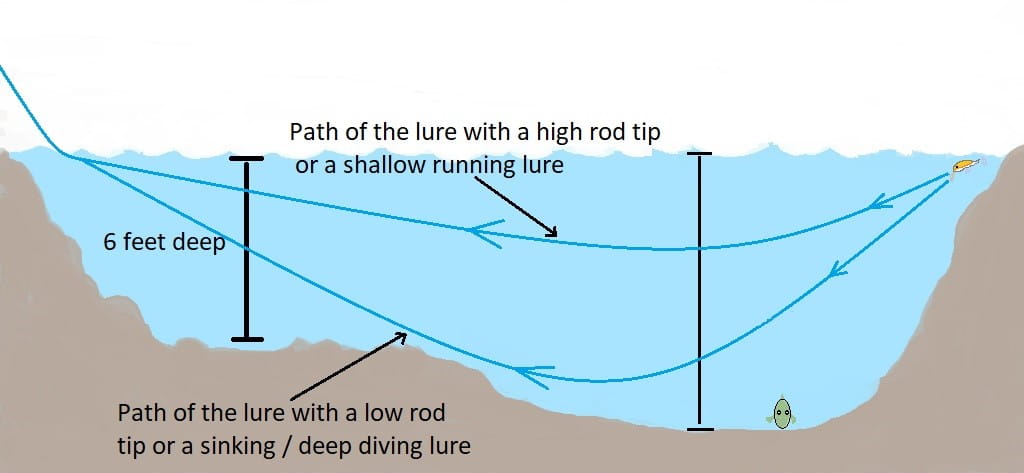
Now you know how to keep your spoon high, and how to get depths and keep it down, now let’s discuss how to figure out how deep your spoon should be.
Most anglers cast out and reel in, and they have no clue how deep their spoon is or how deep the fish are. They have no clue if their lure is 3 feet over the steelhead or 12 feet over the steelhead. Then they cast again in a new spot and repeat. Generally, you need to be 3 to 5 feet away from the steelhead to be in their strike zone.
Determining where the steelhead are in the water column takes a lot of patience. I have seen anglers fish a spot in five minutes but I’ll spend an hour in the same spots, and often, they catch nothing in the same spot that I’ll catch multiple fish.
My methods to cover all levels of the water column goes like this:
- First Cast: I cover the top part of the water column with the first cast by reeling immediately and slowly
- Second Cast: I cast and land my lure in the exact same spot except this time I allow the lure to sink 3 to 6 feet, I lower my rod tip to the water surface or just below the water surface so I can effectively target the middle or lower part of the water column.
- Third Cast: If I haven’t hit a fish or the bottom on the first two casts, I cast back to the exact same spot and I let the spoon sink even longer or all the way to the bottom before starting the retrieval on the third cast. Once it reaches the bottom, lift the rod tip 3 to 6 feet, aiming to keep the spoon suspended 3 to 6 feet above the bottom.
- Repeat: Cast 3 to five feet down the river and repeat. ( I discuss covering the river effectively below)
Pay close attention to the level at which the fish are actively feeding or holding. If you get a bit or bump on any of the 3 casts that could be a sign of where your spoon needs to be. Often, I will get a bite on the 3rd or third cast, which tells me what level the fish are at and then I can eliminate the first or second cast, which allows me to cover the pool faster.
I prefer this slow method of finding the fish better than covering a ton of water fast and hoping my spoon is close to the fish.
What Direction To Cast A Spoon For Steelhead?
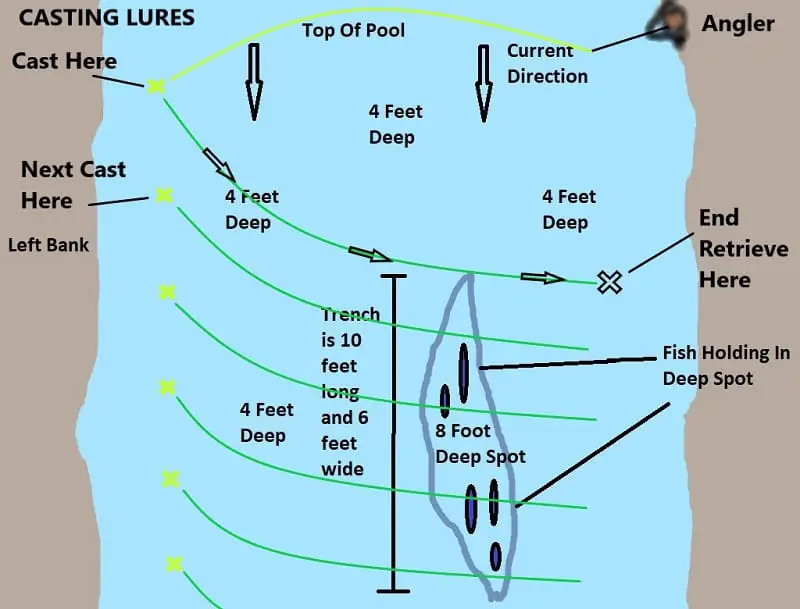
When casting a spoon, I have found that it is generally most effective to cast straight across the river or across and slightly downriver.
While some anglers prefer to cast upriver and retrieve the spoon downriver, my experience suggests that casting straight across leads to much better results.
Casting a spoon upriver gets the spoon deeper, but a spoon coming at the steelhead head-on can spook the steelhead or make it harder for the steelhead to grab it.
However, a spoon fluttering broadside and moving sideways presents an easier and more enticing target for the steelhead which is why an across-river and sideways retrieve is best.
How To Cover The Water With Spoons
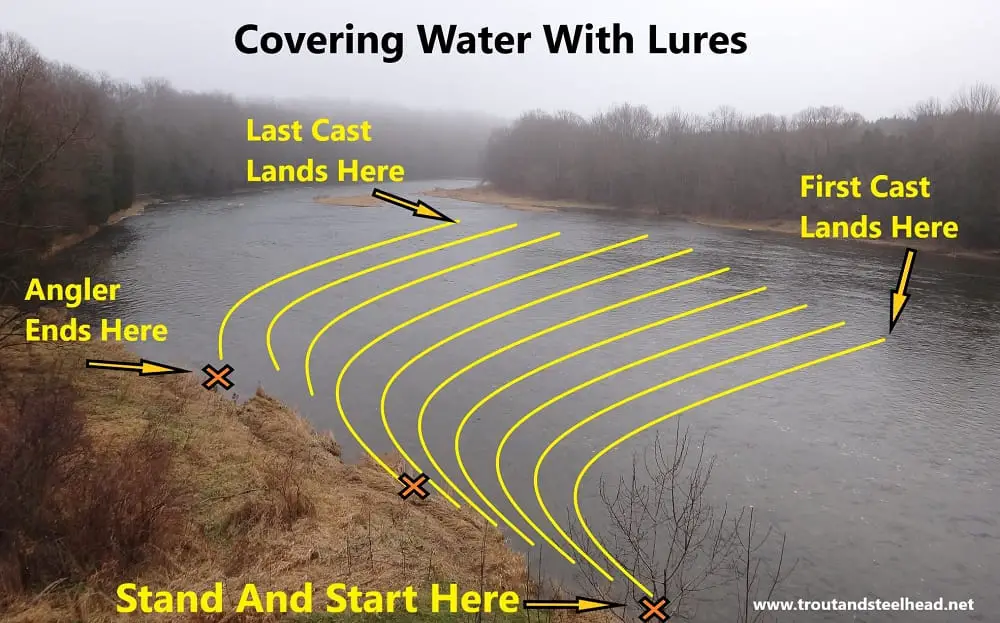
Effectively covering the water is crucial when steelhead fishing with a spoon.
Rather than fan casting or casting randomly in all directions, it’s best to methodically cover the water from the top to the bottom.
I recommend starting your first retrieve at the very top of the spot and moving each cast downriver 3 to 5 feet with each consecutive cast. Three to five feet ensures that each and every fish in the spot sees the spoon and that you leave no gaps, and that the spoon is gradually presented lower and in front of the steelhead with each cast.
Understanding River Conditions For Spoon Selection and Best Method
Understanding river conditions is essential in adapting your fishing methods. Factors such as depth, current speed, water clarity, structure (rocks and logs), and width of the river can influence the behavior of steelhead and how you should target them.
It’s important to be flexible and adjust your approach accordingly.
Clear Water Spoon Fishing
In clear water conditions, you have the advantage of running your lure up to 6 feet away from a steelhead with the potential for bites.
Silver flashy spoons and dark or black-colored spoons work well in clear water. Faster retrieves can be effective as the steelhead can spot the lure from a greater distance and have more time to react.
However, be mindful that in shallow clear water, steelhead can be easily spooked by the splash of the spoon or its proximity. To overcome this, consider using smaller and less flashy spoons, cast them farther away from the fish, and retrieve them at a slower pace while remaining inconspicuous.
If possible, never land your spoon on top of the fish, or in the middle of the pool. Try to get it as close to the far bank as possible and pull the spoon past the fish. This prevents spooking fish in the clear water.
Dirty or Stained Water Spoon Fishing
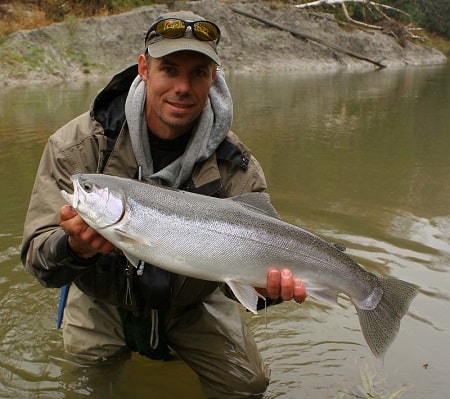
When fishing in dirtier water, or water that is not very clear, it’s critical to get the spoon closer to the steelhead, within a foot or two is best.
Slow down your retrieve to accommodate reduced visibility.
The spoon jigging retrieve is particularly effective in these conditions when steelhead struggle to spot the lure. If the water is very dirty, I even recommend switching to a noisy lure like a spinner or a crankbait with a rattle. A noisy lure helps the steelhead locate and hit the lure when they can’t see it.
I also prefer larger lures or larger spoons and bright chartreuse colors in dirtier water.
Fast and Slow Water Spoon Fishing For Steelhead
In faster water, opt for the swing method, allowing the spoon to move slowly with the current. Avoid reeling in too quickly, as it can cause the spoon to spin or become too fast for the fish to detect and grab.
In slower water, a slow to medium-speed retrieve or jigging retrieve works best. The swing method is less effective in these conditions since a slow current won’t wobble the spoon well and the spoon will likely hit and drag the bottom.
Tight Lines,
Graham,
